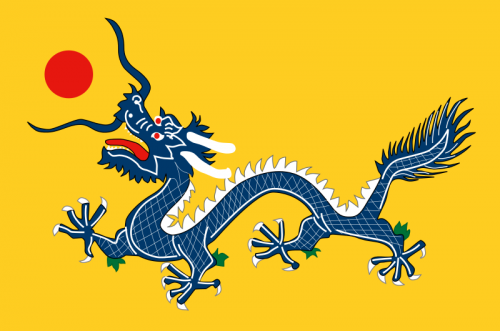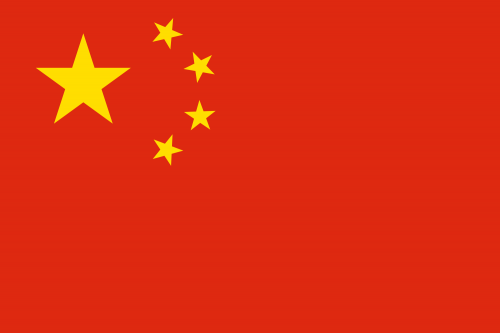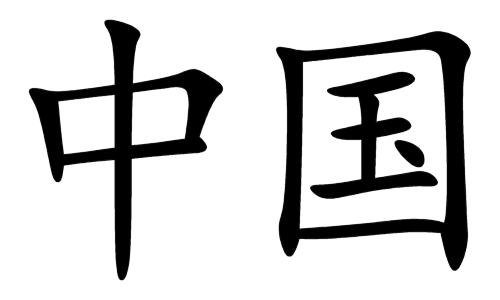BY LETTER
China
Important Nation State of Old Earth | |
 Image from Ryan B | |
| The flag of the Chinese Federal Government (first version) adopted in 201 AT | |
China was a region of Asia on Old Earth with a distinctive family of related cultures. One of the greatest cultural and technological contributors to Terragen society of the Old Earth polities, with a strong legacy even in the Current Era. Many human inhabitants of the Terragen Sphere claim Chinese ancestry.
Prehistory
The land now known as China was first inhabited by pre-humans around 1.5 million years ago. These first inhabitants are now known as Homo erectus. Members of this species, and of later species to inhabit the area, the Denisovans and Homo sapiens (now known as baseline humans), lived in hunter-gatherer societies. This changed with the Agricultural Revolution, which took place in roughly 12,000 BT, and was focused on millet at first. This gave rise to the first Neolithic pre-Chinese cultures, which developed pictographs — the predecessors to later Chinese writing systems.Dynastic Period
These pre-Chinese cultures eventually gave rise to the first dynasties of China. The first known of is the Xia dynasty, which ruled in an area of northern China from 4050 BT to 3580 BT. This was succeeded by the Shang dynasty, the Zhou dynasty, and so forth. Each dynasty tended to rule larger areas, and the early Chinese culture and nation continued to spread southwards, integrating the native peoples. At times, there would be periods where the central dynasty fell, and multiple dynasties vied for power, ruling over different areas of China. At one time, there were hundreds of states existing within present-day China, some as small as a village.During the third millennium BT, many new ideologies were founded in China. The two which have been most enduring and influential were Daoism and Confucianism. Much later, in the 6th century BT, Buddhism would also spread into the country from India, and become highly influential in Chinese philosophy and spirituality. All these philosophies complemented the animistic, polytheistic and ancestor-worshipping traditional folk religion of China.
The dynastic rulers of China were not always of the indigenous Han majority ethnic group. Some dynasties were in fact composed of the descendants of foreign groups, typically nomadic cultures from the north and west of China, who managed to conquer the previous dynasty and usurp their rule. Examples include the Jin dynasty, ruled by Jurchens, and the Yuan dynasty, ruled by Mongol descendants of Genghis Khan.
The Chinese system of governance became very bureaucratic, maintaining a very complex system of scholars and mandarins. The pre-eminence of China (referred to as the Middle Kingdom - between the barbarian lands and Heaven) was paramount. For a long time, China only carried out foreign relations in terms of supplicant-overlord, with neighbouring nations paying tribute to the Chinese Emperors.
Qing Dynasty
There was increasing interference by European governments from the 4th Century BT, almost entirely during the reign of the final Qing dynasty, a Manchu dynasty, which ruled from 335-68 BT. This led to a cracking of this edifice of Chinese absolute power. European governments introduced the narcotic opium, and using this and through many other methods manipulated China for their own benefit.
The Early Republic of China
Eventually, having undergone numerous rebellions and attacks by European forces, the Qing dynasty fell to native Chinese groups, who replaced it with the Republic of China. This would govern China from 67-20 BT, but was wracked by warfare, uprisings, an attempted coup, occupation by Japan and increasing pro-communist agitation. This served to delegitimise Western liberalism in the eyes of the Chinese people, and brought on greater sympathy for the more radical ideas being espoused by Russia in particular. This eventually lead to a split in the Chinese government, with the People's Republic of China, a communist party-led polity, replacing the Republic of China on the mainland, with the latter fleeing to Taiwan, which it continued to rule as the Republic of China.
The Rise of the People's Republic of China
The Communist Party of China governed China as a non-democratic one-party state. During the first century of its existence, the People's Republic of China rose from a state of poverty and disorganisation to the world's largest economy, overtaking the United States of America in the mid-1st Century AT. Through extensive social and economic control, the Communist Party of China guided the country to a state of great prosperity, although this was not felt by all. The poor, in particular in rural areas, did not experience much of this prosperity, being in stark contrast to the modern industrial image of 1st Century China. Additionally, the Tibetan and Uyghur minorities had little identification with the Chinese state, feeling no real identification with China or Chinese culture in general. They sought to achieve independence, or at least a greater level of autonomy, and were heavily discriminated against by the Chinese state based out of Beijing, which sought to integrate them.
Decline of the One-Party System in China
The meteoric rise of the Chinese economy slowed during the 50's AT, stabilising for a time at 30-35% of the global GDP. During this period there were a few economic lurches, including the global recessions of the 60's AT and the Chinese Economic Downturn of 74-76 AT, but generally the economy remained stable. While it continued to grow slowly in absolute terms, it declined relatively to around 10-15% by the end of the Information Age, as a result of the rapid growth of the economies of Nigeria, Indonesia, India and other emerging powers.Economic connections with Sub-Saharan Africa became more important during this period, with state-sponsored Chinese corporations being influential in the development of nations such as Nigeria, Angola, the Democratic Republic of the Congo and Gabon. This also led to some emigration and cultural export from China to these nations. To a lesser extent the inverse also occurred. The African-born and African-descended Chinese populace grew, centred in Guangzhou and Beijing. They became the largest minority of foreign descent by mid-century, tending to culturally assimilate within three or four generations. Nevertheless, proportional to the Chinese population these groups remained miniscule. For much of the 1st Century AT these immigrant groups were marginalised by the government, their citizenships often brought into question, employment often hard to come by. Through a combination of a change in Chinese attitudes and international pressure, this changed during the 80's AT, with their status normalised. Discrimination still remained within the society up until the 100's AT, when this basically subsided too, partly as a result of intermarriage, partly through media exposure to Chinese-speaking people of African descent.
Aside from a general increase in affluence, the major change to China during the later Information Age was political. The Chinese Communist Party (CCP) which had entirely ruled the People's Republic of China since its inception became increasingly diverse, with ever-more discrete factions emerging. The United Front, a coalition of parties essentially subject to the CCP, became more prevalent with those more ideologically divergent CCP members sometimes relocating there, while at the same time techno-savvy new generations of Chinese politicians brought in ever-greater public participation in government, utilising the technologies connecting up the populace to allow the common people to voice concerns and support for policies, as well as organise initiatives. It became increasingly open that the people in local elections were voting for people in different political groupings, rather than members of a monolithic CCP. There was some resistance to this by 'old-school' factions within the CCP, who attempted to quell variation, sometimes resulting in the disappearance of prominent political figures. But many disagreed which factions needed to be purged, and ultimately were unable to stop the changes. Eventually, in 84 AT, the CCP reformed into the Coalition of Chinese Parties, which included its main ideological heir, the Patriotic Socialist Party, as well as the parties of the United Front and a number of splinter-groups derived from factions of the CCP which had been increasingly open about their differences over the last few decades. Only parties approved for membership by the Coalition could join, and only parties within the Coalition were eligible for election. This notably excluded nationalist groups. During the 90's and 100's AT, the first experiments with greater levels of democracy began in provinces like Hubei, Liaoning and the Inner Mongolia Autonomous Region, spurred on by parties enjoying a great deal of public support but less influence than they might like. In such experiments, the people were able to elect the members of the Municipal Congresses directly, and sometimes even the members of the Provincial Congress. Such elections generally too place via emerging technologies such as DNI-authenticated polling. Experiments found that Municipal elections were well-received by the populace, but that Provincial Elections tended to make the Provincial governments too short-sighted and destabilise the economy, as happened famously in Jilin and Liaoning. During this period, there was also increasing delegation of power to the provinces (in particular the long-restive Xinjiang and Tibet/Xizang), allowing for greater diversity of economic and social policy. These experiments were generally successful, and, again supported by popular parties such as the Chinese Federalist Party, elections to the Municipal Congresses were instituted in most Chinese provinces by 130 AT, with the exception of the more state-controlled economic zones such as Shanghai and Shenzhen. Throughout China at this time advancing technologies in the fields of artificial intelligence allowed for the use of subsophont AI to monitor and influence the population and its voting trends.
By the end of the Information Age the role of the state-sponsored corporations in the Chinese economy had stabilised. An array of state-sponsored corporations came to dominate particular industries in China, for example the water industry, the urban agriculture industry and aspects of the biotech industry. Different corporations tended to predominate in particular regions, due in part to connections with different Coalition parties, and in part due to a desire by the central Chinese government to maintain some economic diversity, and also extended beyond China's borders substantially in many cases. In some economic zones, in particular Shenzhen and Guangzhou, this support was absent, and the government encouraged entrepreneurial efforts, despite fear from some quarters that foreign organisations would be too easily able to manipulate the people of these areas. As a result, these were major centres for technological innovation, and attracted ambitious foreigners from Africa, India and Southeast Asia. They also became some of the earliest areas to accept ai and modified humans into society. The level to which they were truly free of the government's economic interference is highly debatable.
Economic Downturn of the 150's
A number of factors contributed to the great economic downturn which beset China in the 150s. Key factors thought to be involved were the greater assertion of economic sovereignty by those emergent Sub-Saharan African economies which had previously been heavily economically involved with China and the steep decline of the use of the yuan (the Chinese currency) as a reserve currency, in favour of the global credit. However, the primary cause seems to have been the ongoing automation of the manufacturing and service sectors without appropriate economic reforms, causing mass unemployment.The economy crashed in 151, and the economic downturn is considered to have lasted until 158. The Chinese Downturn resulted in the Global Downturn, which impacted a great many other economic entities, to varying extents, due to the importance of China in global trade and finance. In China, the national economy shrank for 7 years running, primarily due to a snowball effect of the initial corporation bankruptcies. The fairly traditional economic system of the People's Republic of China meant that many of those made unemployed by the economic troubles had little recourse to fall back on, especially as the resources of the provincial and national governments were also sorely strained. This resulted in the formation of the Downturn Slums, where a number of the destitute ended up thanks to lack of resources or connections to fall back on. Disproportionately represented in these slums were various minorities, including those of immigrant background and some neb and tweak groups. The slums became a festering pit of discrimination against these groups by the primarily-Han Chinese baseline majority.
To cope with the crisis, the government reformed into the Syndicate of Chinese Provinces (SCP), drastically reducing the power in the hands of the central government and giving a great deal more power to the provinces, so they might better find solutions. Ultimately, the continuation of the process of automation and the establishment of free availability of accommodation and resources for all reduced the huge social and economic cost of mass unemployment, while the governments remained funded by their close connections with corporate entities to supplement the taxes received by working citizens. This model was developed in Heilongjiang, Beijing and Shandong, and rapidly spread to other provinces due to its success. Nevertheless, it would take until the 170s for the economy and society to really recover, with an entire generation of young people spending their early years in the Downturn Slums.
The Coalition of Chinese Parties remained generally in charge throughout this process, but in practice the system was changed hugely by the transition to the SCP. The General Assembly was replaced with the Council of Provincial Governments, a much less powerful body, and the Coalition became even broader as different parties diverged and split in different areas of China.
Loss of the Unity of the Chinese State
While the SCP never officially ceased to exist, it eventually became a more and more irrelevant institution over the remainder of the 2nd Century AT, in line with contemporary global trends resulting in the decline of the power of nation states, even ones so ill-defined as the SCP. Having received much more power during the Downturn Reformation, the provinces became the main units of government, and local alliances of provinces more important than nation states. Particular groups of provinces generally run by a particular party or group of associated parties would often work together a great deal, and would become more economically and politically integrated as a result. The most powerful cluster was that in the south and southeast, which constituted Guangdong, Fujian, Hainan, Guangxi, Zhejiang, the Market Zone of Shanghai and the independent Republic of Taiwan, demonstrating the tendency of such co-operative clusters to transcend the old national boundaries. This cluster was dominated by the Party for South Chinese Development and the Chinese Green Party (Neo-Reformed), which were generally in opposition to one another but were roughly balanced in power. The province of Xinjiang tended to act as a bridge between the Central Asian nations and the Central Chinese provinces.Despite this political autonomy, China still remained culturally very much united. The Mandarin language was spoken near-universally (although some groups did work to preserve languages like Wu, Yue and Min Nan) and there was a great deal of migration across the region, and co-operation in major infrastructure projects and technological efforts was common. The Chinese lunar bases were mostly built by agencies run via the Chinese Federal Government (essentially a banner under which the provinces could work together to achieve something), as well as by state- or province-sponsored corporations.
Chinese ideological and cultural trends were by no means always universal, but were not usually separated out along geographical lines, but along social and demographic ones.
 Image from The Astronomer | |
| Chinese Federal Republic Flag (final version) | |
New Ideologies of 2nd through 5th Century China
During the post-Downturn Chinese society, a number of new philosophical and religious ideologies began to take hold. Some of these were developing at the time, others had emerged some time earlier but only now began to flourish, and others were imported from abroad.There were a number of developments in Daoism at this time.
Firstly, Scientific Daoism, or New Daoism, was a Daoistic worldview entirely reconciling Daoist ideas with the atheistic materialist worldview. In the Scientific Daoist view, the Dao was simply the Universe, and to live in harmony with the Universe (often through learning to understand it in scientific terms) was a way by which one could be happy (NB: New Daoism either dispensed of the concept of enlightenment or changed its definition to one of intellectual understanding). This worldview had developed partly in China and partly in North America, and was influenced by Scientific Pantheism.
There also developed Clear Daoism or Nondualist Daoism. This was a Daoist tradition which affirmed the nondualistic nature of Lao Tzu's teachings, and drew substantially on other nondualist traditions to clarify philosophical and practical points. In particular, it drew on Advaita Vedanta, but also on forms of Buddhism. This tradition tended to blur into Old Daoism on the one end and into more 'orthodox' Advaita Vedanta on the other. Within Clear Daoism, there was often a mixing of yogic practices with more traditional Daoist equivalents such as Tai Qi Quan and Qigong.
The third major Daoist tradition emerging in this time was termed Old Daoism. In terms of its terminology and practice, it remained much more traditional than other schools. However, many Daoist masters within this tradition affirmed the agreement of their tradition with that of Clear Daoism, and also often with the different forms of Buddhism in China, and certain Hindu-derived philosophies too. Much more rarely, there was agreement between Clear and Old Daoist masters and learned New Daoists.
As well as these developments of Daoism, there was also development of Confucianism. While more traditional Confucianists did persist, a more influential ideology was that of AI Confucianism. This had actually developed among Confucianist groups in Colombia, Ecuador and Peru, and had since spread to China. In AI Confucianism, the insights and ideas of Confucius were still held to be of great value, but it was thought that the best way of producing a stable and ordered society was through the use of AIs, sophont and non-sophont, in governance and bureaucracy. These groups were among the first to set up their own quasi-independent societies within China.
Moreover, Chan Buddhism and Dzogchen Buddhism both flourished in China during the late 100s and early 200s, with Dzogchen Buddhism spreading beyond Tibet into 'China proper'. The interaction of the two traditions led to the emergence of Emptiness Buddhism in the 240s and '50s. This tradition came to predominate among Chinese Buddhists, and also spread far beyond China.
The Christianity which had established itself in China in the 1st Century AT had developed in a number of directions. A solid Catholic minority had established itself during the 1st Century, but almost entirely switched over to Universalism following the Inner Bull of 193 AT. More prominent were the large Protestant groups within the country. Many became very influenced by the devotionalism of the charismatic movement, even if not outright Pentecostalist themselves. Christianity in China tended not to be so influenced by the Christian atheism which became such a strong trend in the Western world and Sub-Saharan Africa in the 1st and 2nd Centuries. However, China did become one of the centres for the anti-literalist charismatic movement which came to such prominence in 2nd and 3rd Century Christianity. At its high point, Christianity in China reached about 10%, in the mid-2nd Century, but declined following this in favour of other faiths. From the mid-200s onwards Christianity in China became dominated by Living Christianity, the dynamic new denomination founded by Rahman Smith in the United States a few decades earlier, identifying the Soul with God Himself. Living Christianity, or Lifeism, influenced most Christian denominations globally including in China, but was nevertheless most prominent in a more outright manner, in the forms of Charismatic Lifeism, Contemplative Lifeism and other forms. Multiple traditions would emerge within each of these, which were mostly mutually accepting.
Along with neighbouring Pakistan, China was a key locale for the developing Islamic trends retroactively labelled Confucianist Sufism. The literalist fundamentalist trend in 1st Century Islam never really impacted the Chinese Muslim minority, but the opening up of China led to a great deal of interchange with some of the more mystical sects of Islam. However, many Chinese Muslims had long been Confucianist, and with the wider dialogue developing this was formalised during the 2nd Century. Within this belief, the ordering of the society promoted by Islam was best formulated within Confucianism, Confucius having been either a great sage or a prophet sent by God, depending on the philosophical viewpoint.
Most dramatically, a great number of Chinese people came to convert to some of the missionary-oriented Hindu sects of the Interplanetary Age. As well as a number of the Gaudiya Vaishnava organisations descended from ISKCON, Lingayatism and West African Shaivism there came forms of Advaita Vedanta, brought by the Smartist Unity Co-operative and the Institute for Vedantik Education.
While Shenism, the Chinese folk religion, had largely subsided, it remained a strong influence on practices found among the Old and Clear Daoists, within the Shenist Tradition of the Charismatic Lifeists and even among some of the (post-)Hindu groups.
As well as the imported politico-economic ideologies of AI Confucianism and the Anti-Scarcity Movement, which became hugely influential over Chinese society and government, there also developed very influential native streams of thought. An early example of such an ideology was Anarchism with Chinese Characteristics (AwCC). This was a native development of the mutualist school of anarchist thought which emphasised the role of a commonly-owned market economy. AwCC borrowed from the syndicalist school and introduced voluntary federations of consumer and producer co-operatives to help regulate this market. However, the most prominent among these was Boarificationism, a Neo-Pig separatist school of thought.
Many of the first Neo-Pigs were created in China, but faced a great deal of discrimination. They were not generally accepted as people with equal rights, usually lived in slums and ghettos, and at times were abused, driven from their homes, beaten, killed, and even eaten by their persecutors. From this background was born, in many, a strongly anti-human sentiment, asserting the independence and sovereignty of Neo-Pigs, requiring independence from a society which might abuse them. This was a major influence upon Boarificationism. Within this ideology, Neo-Pigs should discover their own true natures by attempting to emulate their wild boar ancestors, who lived in the way most appropriate to their inclinations and mentalities. The vast majority of Boarificationists engineered themselves and their children to resemble wild boar of indigenous Chinese sub-species as opposed to domestic pigs. There was a great deal of diversity within the ideology, with the most radical Boarificationists abandoning human society altogether to set up their own autonomous societies in huge isolated areas in inland China, and often elsewhere on Earth or out in Solsys (while Chinese Neo-Pigs remained the absolute core of the movement, it spread widely beyond the area), speaking their own 're'-constructed language and attempting to live a life more suited to suid nature. The most moderate would live within the human-majority cities, working and interacting with mainstream societies, while endeavouring to replace human-influenced ways of thinking and conceptions with more natural boar ones. Provolves, including Neo-Pigs, did gain full rights in China during the 380s.
Inspired by the most separatist of these Boarificationists, many other groups began founding their own effectively-independent societies in inland and northern China, aided by technological developments allowing societies to flourish in previously untenable areas. Entire new arcologies often emerged in the most deserted areas which were entirely autonomous, in some cases even populated in no small part by people of non-Chinese origins.
Many of these new societies were based on alternative and novel means of running society, including Chinese anarchist, AI Confucianist and Anti-Scarcity experiments, which proved very valuable to testing the effectiveness of their ideas. Autonomous communities promoting spirituality, either in general or affiliated with particular traditions ((post-)Hindu, Buddhist, Daoist, Christian, Muslim, etc) provided an environment which even further elevated the status of China as a global epicentre for many spiritual trends.
Chinese Space-Faring Efforts
During the short window where Earth-based powers were still significant but access to space was readily available, China was very influential, with certain Chinese governments and corporations being key in the great space development projects occurring in the 3rd and 4th Centuries. Chinese resources and labour was important in settling the Asteroid Belt and in setting down roots in the outer system as well. Therefore, Chinese cultural influences were diffused throughout the system, often intermixing with other colonising cultures as well as those which had developed since the dawn of the space colonisation area.
In particular, province-directed efforts were supporters of the emerging predecessors to the Cislunar League, with many provinces establishing close economic ties with particular orbital polities and corporations. What's more, a few Chinese-incubated corporations began to make major industrial developments in the outer system, and eventually would move much of their resources out there, making for substantial infusions of Chinese culture, ideologies and political systems into Belt, Saturnian, Uranian and Neptunian cultures.
While Chinese corporations and governmental agencies were to some extent involved in the settlement and development of the Jovian system, including during the early years of the Jovian League, but the Genetekker dominance of the League, and the resulting rise of the Gengineer Republic, meant that the involved Earth (including Chinese) interests were mostly outside the corporate/government system. These tended to include Chinese biopunks and transhumanists as well as certain spiritual traditions. Chinese Daoists and Buddhists would be important contributors the cultures of many genetekker clades, including Clade Qi Hai and the Biological Stillness Clade.
Furthermore, Chinese corporations and independent groups had been perhaps the most prominent group in the settlement of Antarctica and the eventual establishment of the Antarctic Free States. The Free States of Nanguo and New Gansu were for the most part Chinese in culture and heritage, with both having Mandarin as an official language, alongside Standard Tibetan in the latter. Other Free States with a great deal of Chinese cultural influence included Ross, Eastern Queen Maud and the Second South Chilean Free State. Among many Siberoo provolves, derivatives of Mandarin have long been common as in-clade languages.
China During the Nanotech Age
Chinese societies very cleanly transitioned into full-blown post-scarcity economics, with China having a long history of anti-scarcity, semi-post-scarcity economic systems and experiments and post-scarcity economic thinking. This meant that the advent of nanotech could easily allow it to transition entirely, often led by the more strongly anti-scarcity northern provinces.The old ethnic Han identity began to break down during the Nanotech Age, replaced with a Mandarin-speaking identity, which functioned as a kind of Han-heritage panethnicity, admittedly vague at the edges. This included many ethnic groups, including Plains Mandarins, Southeast Mandarins, Guangzhou Sinicised Africans and Taiwanese. Strong Han identities did however persist among certain Chinese diasporic groups, both on Earth and offworld, particularly in certain Jovian settlements (the Jovian Han towns).
By this stage, the absolute dominance of human baselines in Chinese society had thoroughly subsided, as on much of Old Earth. A huge proportion of the population had received some kind of genetic modification, either personally or ancestrally, and so had become nearbaselines, or even tweaks and superiors. There was a very large ai community, centred in certain cities where they had been historically prominent (Shanghai, Nanjing, Beijing, Shenzhen-Hong Kong, the Heilongjiang arcologies), as well as very large numbers of provolves (mostly Neo-Pigs, but also some sizable communities of Enhanced Dolphins, Parrots and Sufants). There was a smaller, but substantial, vec population, found in the south as well as a few vec-majority settlements in the Gobi Desert, and a few tiny rianth and splice minorities in some cities. This made China a culturally diverse region, right up until the Great Expulsion.
One historically important development during the Nanotech Age was the emergence of Heavenly Palaces, a major corporation which would be instrumental in the colonisation of Sigma Draconis I, later to be known as Penglai.
 Image from Kirran Lochhead Strang | |
| Roundel of the Chinese Federal Space Force, used in the Technocalypse Era and the Last War | |
China in the Technocalypse
While the densely populated old cities of China, mostly along the coast, suffered terribly during the years of the Technocalypse, some other areas survived rather better. Many of the autonomous communities inland were isolated enough to avoid the worst of the disaster, while some arcologies were able to shut down and become self-sufficient, and so weather the tragedy.Nevertheless, there was a great death toll within China, taking a disproportionate toll on the ai population, as well as those parts of the country closely connected to the particularly heavily-hit Japan. Much of the nation's highly nanotech-based manufacturing and agricultural industries were very badly hit, and emergency biotech projects were carried out to produce easily-grown food supplies to keep the country going. The agricultural companies gained a great deal of power, and in some cases became very corrupt, ruling over large regions in an almost neofeudal system, in league with municipal governments or in defiance of them. This led to escalating social inequality, and over the course of the disaster a drain of many people from the coasts and built-up areas into the autonomous communities inland. In some cases, minor brush wars broke out between rapidly-growing autonomous communities of Boarificationists, Vaishnavas, neo-capitalists, anarchists, AI Confucianists and so on and agricultural corporate fiefdoms, as the former expanded their land holdings into marginal areas desired by the latter. Provincial governments acted as arbitrators, often trying to bring these groups under control, with mixed success. Sometimes additional conflicts broke out as the provincial governments attempted to exert control over autonomous groups so as to have a better control over resources to weather the crisis. During this period many of the Vaishnava communities developed theological justifications and reasoning for their growing militancy, and Chinese refugees would form the core of the New Yuga movement, which would produce a number of aggressive Vaishnavist terrorist organisations during the Dark Ages.
Finally, with the Great Expulsion, these troubles were largely brought to a close, replaced by the issues of the Last War. Most Chinese provincial governments encouraged co-operation with GAIA and acquiescing to the expulsion, spending their resources helping to establish space-based infrastructure in cislunar space and further afield, to aid in resettlement efforts. However, some of the autonomous communities and the local corporate fiefdoms established during the Technocalypse resisted very strongly, rising up against GAIA and her agents, and suffering heavy losses before eventually succumbing to the inexorable Expulsion.
Cultural Legacy
The impact of China on the cultures of the Terragen Sphere is hard to overstate.Descendant forms of languages, clades and ideologies developed in China continue to be massively widespread today. The cultural influence of China is still felt strongly in many polities, while being a background feature in many more. The technologies developing in China were a major contributor to the Information and Interplanetary Ages, and therefore to the start of the Terragen expansion.
Mandarin, the primary Chinese language of the Interplanetary Age, has become the founder of one of the largest extant languages families, rivalled only by a few vec- and ai-developed communication protocols and exceeded only by Anglic (which incidentally incorporates many elements derived from Mandarin).
Those humans identifying as 'Chin' continue to persist in large numbers in many polities, as do those claiming heritage from one of the early Chinese interstellar colonies, notably Penglai and the Eridanus League. Via Penglai, Chinese peoples and culture became the primary contributor to the culture of the early NoCoZo. Other early colonies include Huanghua, Lam Wai-Chun and Guo-Shou Jing .
Ideologies developed in China, be they spiritual/religious or political/economic, have been taken up by many and been carried from the homeland by emigrants, both before and during the Great Expulsion, to influence many developing streams of thought. Great religions such as Sophism, Keterism, many forms of Christianity and Buddhism and the corporate religions can credit much of their heritage to Chinese-influenced or -developed thought. What's more, the strains of capitalist, and especially anarcho-capitalist, ideas emerging in Interplanetary Age Chinese provided the grounding for the elaborations later to develop in many polities, notably within the NoCoZo itself.
China in the Gaiacene
Aside from a few sites of great historical importance, including the Forbidden City of Beijing, some of the great Buddhist monasteries and statues, Daoist shrines and the oldest arcology at Harbin, China has been restored to a natural state by GAIA and her agents. A few small communities of the Children of the Earth are the sole sophont inhabitants of the area aside from GAIA herself. Many of these communities are in fact descended, now quite distantly, from the most ecologist and primitivist of the Chinese autonomous communities, including certain primitivist Daoist groups and some of the Suolithic faction of the Boarificationist movement. There are also several of the more typical rianth and other feral communities and a number of hunter-gatherer societies replicating Paleolithic human societies. These seem to include a number of distinct cultures, including Negrito reconstructed groups and proto-Sinic cultures.In terms of the wildlife, China has been restored to plains and forests, with its ancient pre-Neolithic, and even pre-Upper Paleolithic, ecosystems restored. Rhinos, elephants, mammoths, mastodonts, lions, tigers and a huge variety of other fauna once again inhabit their old environments. The Gaiacene Ice Age has produced huge glaciers up in the Himalayas, covering substantial areas of old Tibet/Xizang.
Related Articles
- Chinglish - Text by M. Alan Kazlev
First Federation era hybrid language derived from Anglic, Mandarin and Cantonese, and spoken by ethnic chins. Today it is only found in House Chin, where it is used for formal occasions, among a few ethnolazurogenic clades, or as a novelty language (like Latin, Esperanto, Vzzman, and other dead languages). - Chins, Chinis
- Eridanus Mandarin - Text by Anders Sandberg
Language family derived from Mandarin, a language spoken in China on Old Earth. Emerging in the Eridanus League, it was spoken on various widely dispersed planets in the Inner Sphere, the former Yoson Confederacy and in many Etodist worlds. - Guo-Shou Jing
- Huanghua
- Lam Wai-Chun
- Penglai
- Penglai Empire, The
- Yeung Koon
- Zhang Qian
Appears in Topics
Development Notes
Text by Kirran Lochhead Strang
Building on original material by M. Alan Kazlev and Anders Sandberg
Initially published on 24 September 2001.
Building on original material by M. Alan Kazlev and Anders Sandberg
Initially published on 24 September 2001.











